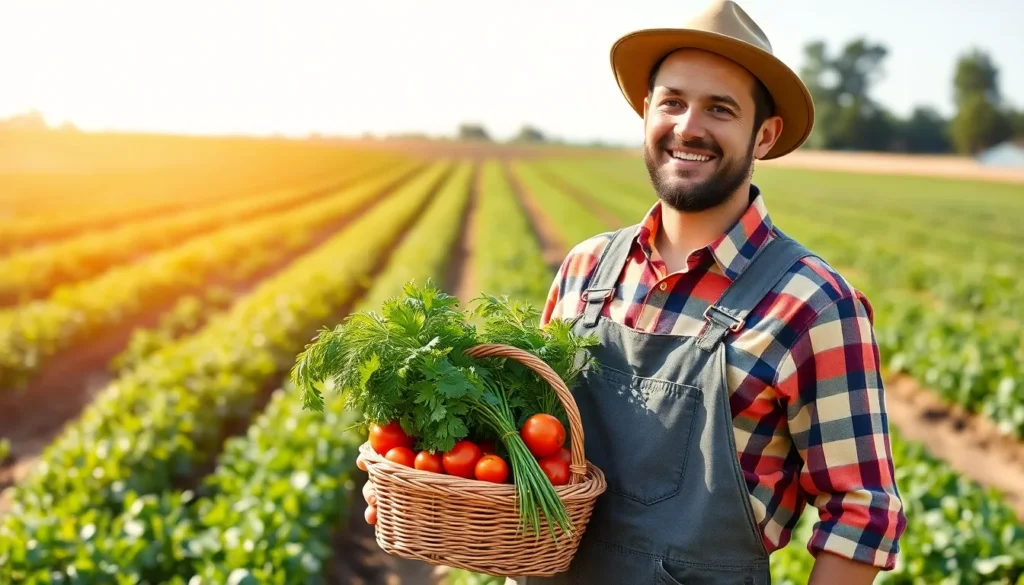Table of Contents
ToggleImagine biting into a juicy tomato that tastes like sunshine, or crunching on a carrot so fresh it practically sings. Welcome to the world of Community Supported Agriculture (CSA), where your food isn’t just a grocery list item, but a vibrant connection to local farmers. It’s like being part of a secret club that delivers delicious, seasonal produce right to your doorstep—or at least to a nearby pick-up spot.
What Is Community Supported Agriculture?
Community Supported Agriculture (CSA) connects consumers directly with local farmers. This model encourages individuals or families to purchase shares of a farm’s harvest in advance. Members typically receive a regular supply of fresh produce throughout the growing season.
Each farm operates differently, providing various crops and products. Some focus on vegetables, while others include fruits, herbs, or even dairy items like eggs and cheese. By participating in a CSA, individuals support sustainable farming practices and promote local food systems.
Financial support from members enables farmers to plan their crops and manage their resources efficiently. Many consumers appreciate this relationship as it fosters a personal connection with the food they eat. They often gain insights into the farming process through farm visits or events organized by the CSA.
Commitments vary among CSA programs. Members might sign up for weekly or bi-weekly deliveries. Sizes of shares can also range from small baskets suitable for individuals to larger options for families.
Transparency is a hallmark of CSAs. Many farmers share their agricultural practices and provide newsletters with helpful recipes or farm updates. This communication strengthens the bond between farmers and the community, ensuring that everyone values local agriculture’s significance.
CSAs represent a modern approach to food sourcing, enriching communities through fresh produce and direct farmer relationships.
Benefits of Community Supported Agriculture

Community Supported Agriculture (CSA) offers numerous advantages for individuals, families, and the environment. Members directly benefit from fresh, local products while supporting sustainable practices.
Environmental Impact
CSAs promote sustainable farming by reducing carbon footprints. Local production lowers transportation emissions, leading to less pollution. Farmers frequently use organic methods, which enhance soil health and biodiversity. Crop diversity also curtails pest outbreaks, reducing the need for chemical pesticides. Additionally, these practices encourage consumers to eat seasonally, fostering a connection to environmental cycles.
Economic Advantages
Participating in a CSA boosts local economies. Financial support from members ensures farmers receive fair compensation, enabling them to invest in their operations. This model sustains family farms and preserves rural jobs. Members often enjoy lower prices than retail markets due to direct purchasing. Investing in a CSA strengthens community ties while ensuring that more money stays within the local economy.
Health Benefits
CSAs encourage healthier eating patterns with access to fresh produce. Members consume seasonal fruits and vegetables rich in nutrients and flavor. Direct access to farm-fresh food leads to less reliance on processed items, fostering better diets. Involvement in a CSA typically increases awareness of food origins, promoting healthier lifestyle choices. Regular consumption of fresh produce correlates with enhanced well-being, supporting both mental and physical health.
How Community Supported Agriculture Works
Community Supported Agriculture (CSA) operates through a direct partnership between consumers and local farmers. This structured relationship fosters a sense of community and supports local food systems.
Membership Structure
Membership in a CSA typically involves purchasing a share of a farm’s harvest before the growing season starts. Various options exist, including weekly or bi-weekly deliveries. Many farms offer different share sizes, which accommodate individuals or larger families. Members receive consistent updates about farm activities and produce availability. Each membership contributes financially, helping farmers plan planting schedules and manage resources effectively. Some CSAs even engage members with events and farm visits, fostering deeper connections and enhancing transparency regarding farming practices.
Seasonal Produce Distribution
Seasonal distribution of produce plays a pivotal role in CSAs. During the growing season, members receive fresh fruits and vegetables harvested at their peak. The variety of crops changes throughout the season, offering an ever-evolving selection that reflects local agriculture. Many CSAs provide newsletters containing recipes and tips tailored to the seasonal bounty. Participants often enjoy unique, flavorful produce that might not be available in standard grocery stores. Through this system, consumers experience the thrill of seasonal eating, promoting appreciation for the local harvest cycle.
Challenges Facing Community Supported Agriculture
Community Supported Agriculture faces various challenges that can impact its viability and growth. Addressing these obstacles remains essential for supporting both farmers and consumers.
Market Competition
Market competition presents a significant challenge for CSAs. With the rise of grocery delivery services and farmers markets, consumers have numerous options for fresh produce. Competing against well-established retailers requires CSAs to emphasize their unique value, such as direct farmer relationships and fresher produce. Adapting to consumer preferences is crucial. Many CSAs explore diverse offerings, including specialty crops and value-added products, to attract customers. Members often seek variety and quality, which can drive CSAs to innovate beyond traditional seasonal subscriptions. Thus, effective marketing strategies enhance visibility and strengthen the connection between farmers and local communities.
Sustainability Issues
Sustainability issues impact the operations of CSAs directly. Weather fluctuations, climate change, and resource management affect crop yields and availability. Many farmers face increased costs due to unpredictable weather patterns, which in turn can lessen the financial stability of CSAs. Community engagement plays a vital role in addressing these concerns. By educating members about sustainable practices, CSAs cultivate understanding and support for farming methods that prioritize environmental health. Farmers often collaborate with local organizations to develop resilience strategies, ensuring effective resource use and long-term sustainability. Prioritizing soil health and biodiversity is essential for maintaining productivity and environmental balance, further benefiting community welfare.
Community Supported Agriculture stands as a transformative model that bridges the gap between consumers and local farmers. It fosters a sense of community while promoting sustainable practices that benefit both the environment and local economies. By choosing to participate in a CSA, individuals not only receive fresh produce but also contribute to the resilience of local food systems. The direct relationship with farmers enhances the overall food experience, making eating seasonally more accessible and enjoyable. As CSAs adapt to challenges and explore innovative offerings, they continue to play a vital role in supporting healthier lifestyles and sustainable agriculture. Embracing this model can lead to a richer connection with food and the land it comes from.




